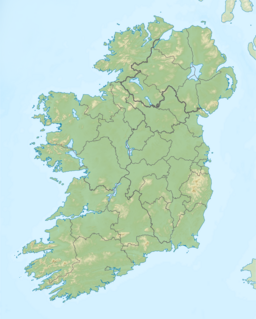
Back Lough Ennell CEB Ennell aintzira Basque Lough Ennell French Loch Ainninn Irish Lough Ennell Italian Lough Ennell NN Lough Ennell Turkish
| Lough Ennell | |
|---|---|
| Loch Ainninn (Irish) | |
 Looking northwest | |
 | |
| Location | Westmeath |
| Coordinates | 53°27′N 7°25′W / 53.450°N 7.417°W |
| Lake type | glacial lake |
| Primary inflows | River Brosna |
| Primary outflows | River Brosna |
| Catchment area | 117.62 km2 (45.41 sq mi) |
| Basin countries | Ireland |
| Max. length | 6.5 km (4.0 mi) |
| Max. width | 2 km (1.2 mi) |
| Surface area | 11.56 km2 (4.46 sq mi) |
| Max. depth | 30 m (98 ft) |
| Surface elevation | 81 m (266 ft) |
| References | [1][2] |
| Designated | 7 June 1996 |
| Reference no. | 848[3] |
Lough Ennell (Irish: Loch Ainninn)[4] is a lake near the town of Mullingar, County Westmeath, Ireland. It is situated beside the N52 road, off the Mullingar/Kilbeggan road.[5] The lake is part of the Lough Ennell Special Protection Area.[1] It is 6.5 km (4.0 mi) long by 2 km (1.2 mi) wide,[1] with an area of about 12 km2 (4.6 sq mi).[2] Lough Ennell has a large area of shallow water with nearly two-thirds of its area being less than 25 feet (8 m) and almost half of it being under 10 ft (3.0 m) deep. The lake produced Ireland's largest ever lake brown trout at 26 lbs (11.8 kg).[6][7]
The main river flowing into Lough Ennell is the River Brosna, which enters on the Mullingar side of the lake and exits on the opposite side at Lilliput. Lilliput and Lilliput House were frequently used by Jonathan Swift as a holiday home and place to write, local tradition states that Jonathan Swift was in a boat on the lake when he looked back at Lilliput and noticed how small the people looked at that distance, hence the inspiration for his most famous book Gulliver's Travels.[citation needed] Lilliput at the time was called "Nure" however after the publication of Gulliver's Travels locals began to refer to the lakeshore as Lilliput, the name stuck and today the area is known as Lilliput.
- ^ a b c "Lough Ennell SPA". National Parks and Wildlife Service (Ireland). Retrieved 28 March 2020.
- ^ a b Free, Gary; Little, Ruth; Tierney, Deirdre; Donnelly, Karol & Caroni, Rossana (2006). A Reference Based Typology and Ecological Assessment System for Irish Lakes (PDF) (Report). Environmental Protection Agency (Ireland). p. 11. Retrieved 15 October 2022.
- ^ "Lough Ennell". Ramsar Sites Information Service. Retrieved 25 April 2018.
- ^ "Loch Ainninn/Lough Ennell". Placenames Database of Ireland (logainm.ie). Retrieved 15 October 2022.
- ^ "Lough Ennell". Discover Ireland. Archived from the original on 10 May 2009. Retrieved 8 March 2009.
- ^ "Fishery: Lough Ennell". Shannon Regional Fisheries Board. Archived from the original on 23 February 2009. Retrieved 8 March 2009.
- ^ "Lough Ennell - The Name". Ask About Ireland. Archived from the original on 23 November 2007. Retrieved 8 March 2009.
